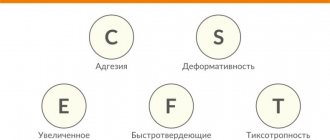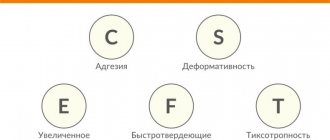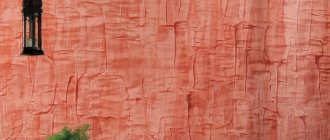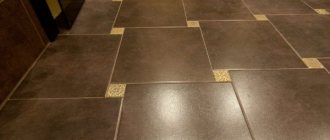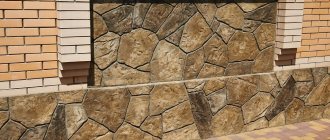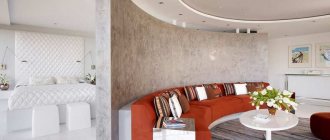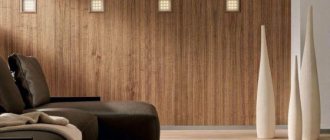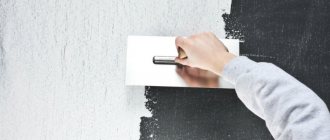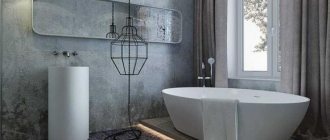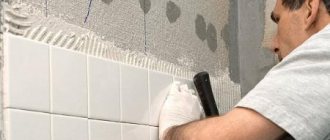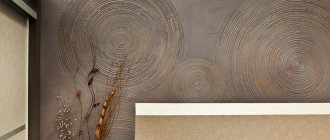Choosing a high-quality base for plastering walls often comes down to finding a reliable and sometimes expensive material - an adhesive mixture for fixing the tiles. The composition should have increased adhesive characteristics, ease of use and rapid hardening.
Is it still possible to use tile adhesive instead of plaster?
On construction forums there are often discussions on the topic: “Is it possible to plaster with tile adhesive, for example, in a bathroom. In most cases, this is due to the purchase of a large amount of glue, which remains after repair work. When considering the possibility of using decorative plaster from tile adhesive, you should consider both the pros and cons of such a solution.
Each type of adhesive base has its own characteristics, but modern options are universal. Leading suppliers indicate on the packaging that the adhesive can be used as a plaster. For example, products from Ceresit are labeled “for leveling wall surfaces.”
However, it is important to consider that this finishing option does not guarantee the same strength as traditional plaster.
General information
It would seem that each building material has its own purpose, so tiles should be glued with glue, and walls should be leveled with plaster and nothing else. However, tile adhesive even has some advantages over conventional plaster, which we will discuss below.
In addition, many home craftsmen have successful experience in decorating walls with their own hands. But, at the same time, it cannot be said unequivocally that this can be done, since this operation has a number of its own nuances, which are described below.
Leveling the wall with tile adhesive
Tile adhesive and its properties
Tile adhesive for plaster is a ready-made product or a dry mixture based on cement or other hardeners. The compositions are intended for fastening finishing materials made from derivatives of concrete, brick and clay on concrete or brick surfaces. Old releases of tile adhesive were no different from cement-sand mortar, but soon the most durable and reliable solutions with high performance and versatility were released.
Types of glue
Depending on the characteristics of the composition, the mixture is divided into 3 groups:
- Dry products based on cement with resins in the composition.
- Dispersion solutions, ready for use.
- Liquid Nails. Manufactured on the basis of polymer components to eliminate minor defects.
The most popular are dry mixtures, which are characterized by affordable cost and ease of use. The type and state of the final consistency depends on the concentration of water and sand. There are also epoxy compounds consisting of resins and other synthetic components that provide resistance to negative factors and ductility.
Dispersion options are expensive, but have a short drying time. Due to their increased ductility, they can be used under high mechanical loads. But due to the high cost and a number of difficulties when distributing over large areas, such adhesives are used exclusively for their intended purpose.
Liquid nails containing rubber have a maximum safety margin. They can be used outdoors rather than inside buildings.
Properties of adhesives
Dry mixtures, which are often used for plastering walls, have the following characteristics:
- Increased adhesive properties.
- Plastic.
- Resistance to adverse environmental influences (high temperature and humidity).
- Intensive drying.
Is it worth it and is it possible to glue tiles onto gypsum plaster: features of the coating
Gypsum has been used in construction for a long time; this coating has proven itself to be the best, since the mass is quite pleasant to work with, does not contain rough impurities, is distinguished by the presence of a pleasant color and dries quickly.
To glue the tiles, you do not need to apply too thick a layer of gypsum plaster
In addition to a large number of advantages, this material also has several disadvantages that can affect the laying of tiles on top of it:
- When coated with gypsum as a plaster, it can form a porous structure, which can negatively affect the tiles laid on top.
- Due to its structure, gypsum also quickly absorbs the moisture that appears, as a result of which the coating softens and fungus and mold form.
- This coating is also not durable, especially when any blows are applied, dents remain and chips occur.
- When in contact with metal objects, gypsum is capable of destroying them, giving way to corrosion.
Related article: DIY curtains: step-by-step instructions (photo)
The most suitable gypsum base will be for painting or wallpapering, but with tiles you need to be more careful and attentive. An additional primer on top of the gypsum base has more pros than cons - the strong porosity of the surface is reduced, as a result of which it is strengthened, a dense water-repellent film is created, preventing fungi and mold from spreading. This also increases the strength of the coating and its adhesion to further decorative material.
Pros and cons of this solution
When planning to plaster walls using tile adhesive, you need to consider both the advantages and disadvantages of such a solution.
The positive aspects include the following points:
- Possessing high adhesiveness, the solution quickly and efficiently adheres to the concrete surface.
- With minimal density, the composition will not slide down and is retained on the surface being treated.
- The glue has plasticity and workability, and its hardening time allows you not to rush with installation.
- Advanced mixtures meet environmental standards, are resistant to temperature changes, and are comparable in mechanical strength to cement plasters.
- The glue can be used for finishing facades.
In some properties, substances based on glue are superior to gypsum compositions and putty products. For example, when used in the bathroom, such mixtures are irreplaceable. They do not peel off, despite wet conditions of use, are not damaged by impact or pressure, and also do not allow moisture to reach the walls. If gypsum is afraid of water and quickly bursts, then the glue continues to retain its performance properties for a long time.
However, before the puttying procedure with glue, the method must also take into account
negative properties of the method. Among them:
- High price.
- Impossibility of applying the mass in a layer of 10 mm or more. If greater thickness is required to obtain a smooth surface, the mass will have to be applied in several layers. With plaster you can use layers as thin as 1 cm.
- A number of difficulties when working with glue.
How much does groove putty cost?
Gating works
| I. Grilling for electrical wiring | ||
| № | Types of jobs | Price, rub.) |
| 22. | Putting plaster mixture on electric grooves up to 20mm on the wall | 20 |
| 23. | Putting plaster mixture on electric grooves up to 40mm on the wall | 30 |
| 24. | Putting plaster mixture on electric grooves up to 60mm on the wall | 40 |
Leveling walls with tile adhesive
If, during renovation work, tiles were removed from the walls of the bathroom, then under it there may be a layer of old glue or leveling plaster. The process of removing adhesive that is firmly fixed to the wall requires time and effort. In addition, after this you will have to putty the wall with a gypsum or cement-sand mixture and reapply glue.
A simpler and cheaper method is to level the surface without dismantling the previous coating, and when the solution dries, the new tile must be fixed with a similar composition.
The alignment algorithm is as follows:
- First you need to prepare the base.
- Then you need to fix the beacons and apply 1-2 layers of plaster.
- Next, the surface needs to be dried and finishing activities can begin, for example, applying tiles to plastered walls.
Preparing the base
Despite the improved adhesive properties of the mixture, the base for future finishing must be prepared with special care:
- Loose and fragile materials must be removed from the surface of the walls (plaster is removed, this applies to wallpaper, tiles and peeling plaster).
- Metal hardware that may be subject to corrosive processes must be removed, and the remaining elements treated with an oil base.
- All efflorescence, traces of grease, soot and other contaminants that may impair adhesive properties must be removed from the coating.
- All cracks, chips and other defects must be treated with a primer and restored using reinforced mesh.
- After this, you need to get rid of the dust and apply a layer of primer, guided by the type of base material.
- If necessary, you need to install a reinforcing mesh and place beacons.
Installing beacons on the wall
To get rid of minor defects, you can use beaconless methods. So, someone levels the mixture with a wide spatula or a rule after application. But if you have to use layers with a thickness of 6 mm or more, it is better to use beacons. To do this, you should secure the beacon strips using a level and a special sequence of actions.
First you need to measure the walls and determine the most convex area. If it is not possible to eliminate the protrusions, then this point can be used as a guide for arranging an additional surface of beacons.
Beacon strips can be made from gypsum mortar or using string beacons. The optimal distance between the slats is from 1 to 1.5 meters (taking into account the parameters of the rule).
Tile mixtures are more sticky than plaster mixtures, so it is quite difficult to level them using a rule. Therefore, it is better for novice craftsmen to use a short tool with a meter bar.
Preparation of the solution
To prepare plaster solutions based on dry glue mixtures, you must adhere to a strict recipe and sequence of actions. First of all, you should pour the powder from the packaging into a container with warm water, and then mix the components with a mixer for 3-4 minutes. Then the product should be left for 10 minutes to mature and repeat the procedure again.
Before carrying out work, you should familiarize yourself with the operational terms of the composition so as not to prepare more solution than will be consumed.
The glue must be sealed immediately before use. The finished solution is covered with a lid to prevent prolonged contact with air masses. The remaining dry mixture should be sealed and placed in a dry storage room.
How to plaster with tile adhesive
Plaster the wall with tile adhesive strictly according to the instructions indicated on the package.
You need to work with adhesive bases subject to a number of rules and conditions:
- The temperature should vary between +5-30°C.
- The concentration of water for hardening the mixture should not exceed that specified in the instructions.
- The optimal layer thickness is no more than the recommended 10 mm.
- The diluted solution does not need to be rejuvenated - it must be consumed within 20 minutes from the moment of preparation.
- Before applying subsequent layers or before gluing tiles, you must thoroughly dry the previous base.
- Some adhesives have restrictions on their use or specific conditions that must be met.
- If you plan to apply the mixture in a layer of 10 mm or more, the hardening surface may be subject to cracking. Often the problem is solved by adding sand, but it is better not to deviate from the recommended thickness.
- It is important to adhere to the intermediate application of the primer between coats.
Initially, adhesives were not used for plastering, so they are quite greasy due to the increased concentration of cement. In order for the solution to be properly applied to the surface, sand should be included in the composition. If the product sticks to the trowel too quickly, you need to reduce the fat content.
Types of tile adhesive
Leading suppliers of adhesive mixtures offer a wide range of compositions with different performance properties and differences.
Depending on the strength and characteristics, the following types are distinguished:
- Universal
— Suitable for repair work of medium complexity.
- Moisture resistant
- used in car washes, swimming pools, kitchens, shower rooms and other rooms where high humidity occurs.
- Reinforced
— characterized by an increased margin of safety and adhesion.
- For facade work
— are frost-resistant and can withstand repeated freezing, so they can be used outdoors.
- Heat resistant
— intended for application to fireplaces and stoves.
Moisture-resistant varieties contain substances that prevent the growth of mold and fungi.
There are 2 main forms of glue available for sale:
- Dry powder mixtures.
- Ready-made viscous solutions.
Cement is used as the base for the glue. The composition also includes polymers, for example, latex or polyurethane. The frost resistance of façade adhesive declared by the manufacturers reaches 35 cycles.
